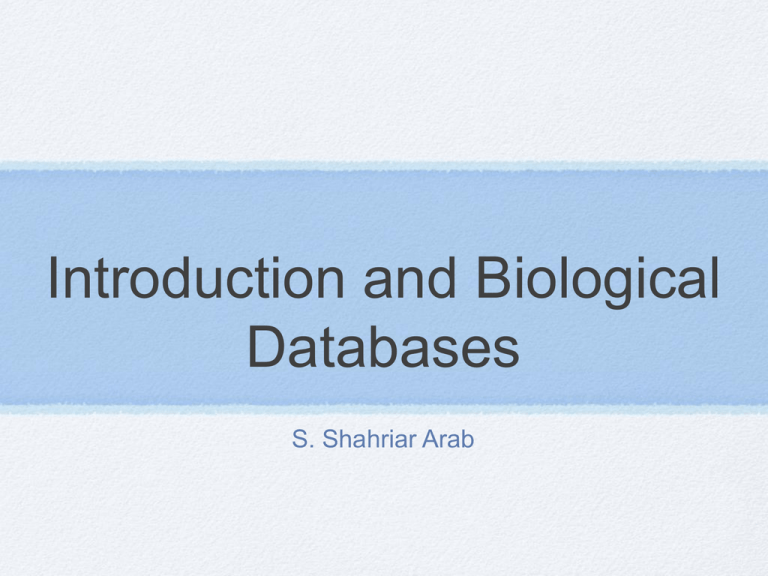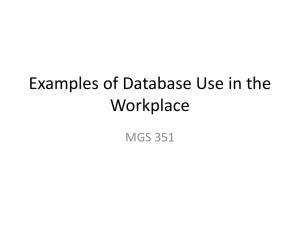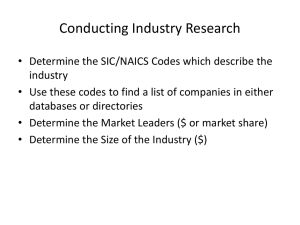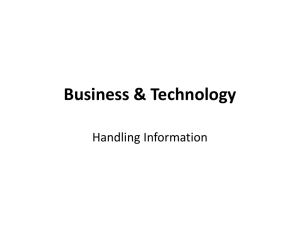Introduction to Bioinformatics and Biological Databases
advertisement

Introduction and Biological
Databases
S. Shahriar Arab
Overview
Introduction to biological Databases
Introduction
What Is a Database?
What Is
Types
of Databases
Bioinformatics?
Biological
Databases
Goal
Scopeof Biological databases
Pitfalls
Applications
Information
Retrieval from Biological
databases
Limitations
What is Bioinformatics?
Bioinformatics involves the technology that uses
computers for storage, retrieval, manipulation,
and distribution of information related to
biological macromolecules
Bioinformatics & Computational Biology
Goal
Better understand a living cell and how it
functions at the molecular level
Scope
The development of computational tools and
databases
The application of these tools and databases in
generating biological knowledge
Scope
Tools development:
Writing software for sequence, structural, and
functional analysis
Construction and curating of biological
databases
Tools: Used in three areas
Molecular Sequence Analysis
Molecular Structural Analysis
Molecular Functional Analysis
Sequence Analysis
Sequence Alignment
Sequence Database Searching
Motif and Pattern Discovery
Gene and Promoter Finding
Reconstruction of Evolutionary Relationships
...
Structural Analysis
•
Protein and nucleic acid structure
Analysis
Comparison
Classification
Prediction
Functional Analysis
Gene Expression Profiling
Protein– Protein Interaction Prediction
Protein Sub cellular Localization Prediction
Metabolic Pathway Reconstruction
...
Applications
Drug design
Agricultural biotechnology
Forensic DNA analysis
Limitations
Fighting a battle without intelligence is inefficient
and dangerous
Introduction to Biological
Databases
What is a Database?
Type of Databases:
Relational Databases
Object-Oriented Databases
Biological Databases
Primary Databases
Secondary Databases
Databases in Bioinformatics
Sequence databases
Sequence analysis
Functional genomics
Literature databases
Structural databases
Metabolic pathway databases
Specialized databases
Pitfalls of Biological Databases
Errors in Sequence Databases
Redundancy in the Primary Sequence
Databases
False or Incomplete Genes Annotations
Errors in Nucleotide Sequences
sequencing errors
frame-shifts
Contaminated with sequences from cloning
vectors
Exceptional Care for sequences produced
before the 1990s
Redundancy
repeated submission
identical or overlapping sequences by the same
or different authors
revision of annotations
dumping of expressed sequence tags (EST)
data
poor database management
Bioinformatics Databases
Growing steadily in number
Growing amazingly in size
Specialization
Which genome they contain (mouse, human, all of them)
Which types of information about the genome they contain
Contain information such as
Sequences: of bases and of residues
Structure: 3d conformations of known proteins
Families: Which sets of genes are known to be homologous
Annotations: which processes each gene is involved in
And lots of other information
The definitive source….
•
More than 1300 DB
•
http://nar.oxfordjournals.org/content/39/suppl_1.toc
DNA Sequence databases
Main repositories:
GenBank (US)
(http://www.ncbi.nlm.nih.gov/Genbank/index.html)
EMBL (Europe)
(http://www.ebi.ac.uk/embl/)
DDBJ (Japan)
(http://www.ddbj.nig.ac.jp/)
Primary databases
DNA sequences are identical
EMBL Database
Number of entries
(current 199,575,971)
Graphs created on 22 November 2010
http://www.ebi.ac.uk/embl/Services/DBStats/
www.ncbi.nlm.nih.gov
ENTREZ
NCBI (USA) National Center for Biotechnology Information
PubMed: The biomedical literature (PubMed)
Nucleotide sequence database (Genbank)
Protein sequence database
Structure: three-dimensional macromolecular structures
Genome: complete genome assemblies
PopSet: population study data sets
OMIM: Online Mendelian Inheritance in Man
Taxonomy: organisms in GenBank
Books: online books
ProbeSet: gene expression and microarray datasets
3D Domains: domains from Entrez Structure
UniSTS: markers and mapping data
SNP: single nucleotide polymorphisms
CDD: conserved domains
Journals: journals in Entrez
UniGene: gene-oriented clusters of transcript sequences
PMC: full-text digital archive of life sciences journal literature
http://www.ncbi.nlm.nih.gov/Entrez/
PubMed is…
• National Library of Medicine's search service
• >20 million citations in MEDLINE
• links to participating online journals
• PubMed tutorial (via side bar)
Entrez integrates…
• the scientific literature;
• DNA and protein sequence databases;
• 3D protein structure data;
• population study data sets;
• assemblies of complete genomes
Entrez is a search and retrieval system
QuickTime™ and a
TIFF (Uncompressed) decompressor
are needed to see this picture.
Sequence Databases
Annotated sequence databases
SWISS-PROT, GenBank etc…
Usage: identifying function, retrieving information
Low-annotation sequence databases
EST databases, high-throughput genome sequences
Usage: discovery of new genes
General Protein Databases
SWISS-PROT
–
Manually curated
–
high-quality annotations, less data
GenPept/TREMBL
–
Translated coding sequences from GenBank/EMBL
–
Few annotations, more up to date
PIR
–
Phylogenetic-based annotations
All 3 now combining efforts to form UniProt (http://www.uniprot.org)
Low-annotation Databases
ESTs (Expressed Sequence Tags)
Low quality sequences generated by high volume sequencing the 3’ or 5’ end of cDNAs
High-throughput genome sequences
Produced by mass-sequencing of genomic
DNA
Non-redundant Databases
Sequence data only: cannot be browsed, can only
be searched using a sequence
Combine sequences from more than one database
Examples:
NR Nucleic (genbank+EMBL+DDBJ+PDB
DNA)
NR Protein (SWISSPROT+TrEMBL+GenPept+PDB protein)
Sequence & Structure Databases
PDB (Protein Databank)
Stores 3-dimensional atomic coordinates for biological molecules including protein and
nucleic acids
Data obtained by X-ray crystallography, NMR, or computer modelling
http://www.rcsb.org/pdb/
MMDB (Molecular Modelling database)
Over 28,000 3D macromolecular structures, including proteins and polynucleotides
(http://www.ncbi.nlm.nih.gov/entrez/query.fcgi?db=Structure)
SCOP (Structural Classification of Proteins)
Classification of proteins according to structural and evolutionary relationships
File Formats
GenBank/GB, genbank flatfile format
NBRF format
EMBL, EMBL flatfile format
Swissprot
GCG, single sequence format of GCG software
DNAStrider, for common Mac program
Pearson/Fasta, a common format used by Fasta programs and others
Phylip3.2, sequential format for Phylip programs
Phylip, interleaved format for Phylip programs (v3.3, v3.4)
Plain/Raw, sequence data only (no name, document, numbering)
MSF multi sequence format used by GCG software
PAUP"s multiple sequence (NEXUS) format
ASN.1 format used by NCBI
EMBL Format
ID TRBG361 standard; mRNA; PLN; 1859 BP.
XX
AC X56734; S46826;
XX
SV X56734.1
XX
DT 12-SEP-1991 (Rel. 29, Created)
DT 15-MAR-1999 (Rel. 59, Last updated, Version 9)
XX
DE Trifolium repens mRNA for non-cyanogenic betaglucosidase
XX
KW beta-glucosidase.
XX
OS Trifolium repens (white clover)
OC Eukaryota; Viridiplantae; Streptophyta; Embryophyta;
Tracheophyta;
OC Spermatophyta; Magnoliophyta; eudicotyledons; core
eudicots; rosids;
OC eurosids I; Fabales; Fabaceae; Papilionoideae;
Trifolieae; Trifolium.
XX
RN [5]
RP 1-1859
RX MEDLINE; 91322517.
RX PUBMED; 1907511.
RA Oxtoby E., Dunn M.A., Pancoro A., Hughes M.A.;
RT "Nucleotide and derived amino acid sequence of the
cyanogenic
RT beta-glucosidase (linamarase) from white clover
(Trifolium repens L.).";
RL Plant Mol. Biol. 17(2):209-219(1991).
XX
RN [6]
RP 1-1859
RA Hughes M.A.;
RT ;
RL Submitted (19-NOV-1990) to the EMBL/GenBank/DDBJ
databases.
RL M.A. Hughes, UNIVERSITY OF NEWCASTLE UPON TYNE,
MEDICAL SCHOOL, NEW CASTLE
RL UPON TYNE, NE2 4HH, UK
XX
DR GOA; P26204.
DR MENDEL; 11000; Trirp;1162;11000.
DR SWISS-PROT; P26204; BGLS_TRIRP.
XX
FH Key Location/Qualifiers
FH
FT source 1..1859
FT /db_xref="taxon:3899"
FT /mol_type="mRNA"
FT /organism="Trifolium repens"
FT /tissue_type="leaves"
FT /clone_lib="lambda gt10"
FT /clone="TRE361"
FT CDS 14..1495
FT /db_xref="GOA:P26204"
FT /db_xref="SWISS-PROT:P26204"
FT /note="non-cyanogenic"
FT /EC_number="3.2.1.21"
FT /product="beta-glucosidase"
FT /protein_id="CAA40058.1"
FT /translation="MDFIVAIFALFVISSFTITSTNAVEASTLLDIGNLSRSSFPRGFI
FT FGAGSSAYQFEGAVNEGGRGPSIWDTFTHKYPEKIRDGSNADITVDQYHRYKEDVGIMK
FT DQNMDSYRFSISWPRILPKGKLSGGINHEGIKYYNNLINELLANGIQPFVTLFHWDLPQ
FT VLEDEYGGFLNSGVINDFRDYTDLCFKEFGDRVRYWSTLNEPWVFSNSGYALGTNAPGR
FT CSASNVAKPGDSGTGPYIVTHNQILAHAEAVHVYKTKYQAYQKGKIGITLVSNWLMPLD
FT DNSIPDIKAAERSLDFQFGLFMEQLTTGDYSKSMRRIVKNRLPKFSKFESSLVNGSFDF
FT IGINYYSSSYISNAPSHGNAKPSYSTNPMTNISFEKHGIPLGPRAASIWIYVYPYMFIQ
FT EDFEIFCYILKINITILQFSITENGMNEFNDATLPVEEALLNTYRIDYYYRHLYYIRSA
FT IRAGSNVKGFYAWSFLDCNEWFAGFTVRFGLNFVD"
FT mRNA 1..1859
FT /evidence=EXPERIMENTAL
XX
SQ Sequence 1859 BP; 609 A; 314 C; 355 G; 581 T; 0 other;
aaacaaacca aatatggatt ttattgtagc catatttgct ctgtttgtta ttagctcatt
cacaattact tccacaaatg cagttgaagc ttctactctt cttgacatag gtaacctgag
tcggagcagt tttcctcgtg gcttcatctt tggtgctgga tcttcagcat accaatttga
aggtgcagta aacgaaggcg gtagaggacc aagtatttgg gataccttca cccataaata
tccagaaaaa ataagggatg gaagcaatgc agacatcacg gttgaccaat atcaccgcta
caaggaagat gttgggatta tgaaggatca aaatatggat tcgtatagat tctcaatctc
ttggccaaga atactcccaa agggaaagtt gagcggaggc ataaatcacg aaggaa
60
120
180
240
300
360
Genbank Format
LOCUS
SCU49845
5028 bp
DNA
PLN
21-JUN-1999
DEFINITION Saccharomyces cerevisiae TCP1-beta gene, partial
cds, and Axl2p
(AXL2) and Rev7p (REV7) genes, complete cds.
ACCESSION
U49845
VERSION
U49845.1 GI:1293613
KEYWORDS
.
SOURCE
Saccharomyces cerevisiae (baker's yeast)
ORGANISM Saccharomyces cerevisiae
Eukaryota; Fungi; Ascomycota; Saccharomycotina;
Saccharomycetes;
Saccharomycetales; Saccharomycetaceae;
Saccharomyces.
REFERENCE
1 (bases 1 to 5028)
AUTHORS
Torpey,L.E., Gibbs,P.E., Nelson,J. and
Lawrence,C.W.
TITLE
Cloning and sequence of REV7, a gene whose function
is required for
DNA damage-induced mutagenesis in Saccharomyces
cerevisiae
JOURNAL
Yeast 10 (11), 1503-1509 (1994)
MEDLINE
95176709
PUBMED
7871890
REFERENCE
2 (bases 1 to 5028)
AUTHORS
Roemer,T., Madden,K., Chang,J. and Snyder,M.
TITLE
Selection of axial growth sites in yeast requires
Axl2p, a novel
plasma membrane glycoprotein
JOURNAL
Genes Dev. 10 (7), 777-793 (1996)
MEDLINE
96194260
PUBMED
8846915
REFERENCE
3 (bases 1 to 5028)
AUTHORS
Roemer,T.
TITLE
Direct Submission
JOURNAL
Submitted (22-FEB-1996) Terry Roemer, Biology, Yale
University, New
Haven, CT, USA
FEATURES
Location/Qualifiers
source
1..5028
/organism="Saccharomyces cerevisiae"
/db_xref="taxon:4932"
/chromosome="IX"
gene
CDS
687..3158
/gene="AXL2"
687..3158
/gene="AXL2"
/note="plasma membrane glycoprotein"
/codon_start=1
/function="required for axial budding pattern of
cerevisiae"
/product="Axl2p"
/protein_id="AAA98666.1"
/db_xref="GI:1293615"
/translation="MTQLQISLLLTATISLLHLVVATPYEAYPIGKQY
TFQISNDTYKSSVDKTAQITYNCFDLPSWLSFDSSSRTFSGEPSSDLL
VILEGTDSADSTSLNNTYQFVVTNRPSISLSSDFNLLALLKNYGYTNG
VFNVTFDRSMFTNEESIVSYYGRSQLYNAPLPNWLFFDSGELKFTGTA
TSYSFVIIATDIEGFSAVEVEFELVIGAHQLTTSIQNSLIINVTDTGN
YLDDDPISSDKLGSINLLDAPDWVALDNATISGSVPDELLGKNSNPAN
DVIYFNFEVVSTTDLFAISSLPNINATRGEWFSYYFLPSQFTDYVNTN
DHDWVKFQSSNLTLAGEVPKNFDKLSLGLKANQGSQSQELYFNIIGMD
NATSTRSSHHSTSTSSYTSSTYTAKISSTSAAATSSAPAALPAANKTS
CGVAIPLGVILVALICFLIFWRRRRENPDDENLPHAISGPDLNNPANK
NPFDDDASSYDDTSIARRLAALNTLKLDNHSATESDISSVDEKRDSLS
SQSKEELLAKPPVQPPESPFFDPQNRSSSVYMDSEPAVNKSWRYTGNL
YGSQKTVDTEKLFDLEAPEKEKRTSRDVTMSSLDPWNSNISPSPVRKS
HRNRHLQNIQDSQSGKNGITPTTMSTSSSDDFVPVKDGENFCWVHSME
VDFSNKSNVNVGQVKDIHGRIPEML
1510 a
1074 c
835 g
1609 t
BASE COUNT
ORIGIN
1 gatcctccat
61 ccgacatgag
121 ctgcatctga
181 gaaccgccaa
241
atacaacggt
acagttaggt
agccgctgaa
tagacaacat
atctccacct
atcgtcgaga
gttctactaa
atgtaacata
caggtttaga
gttacaagct
gggtggataa
tttaggatat
tctcaacaac
aaaacgagca
catcatccgt
acctcgaaaa
ggaa
gtag
gcaa
taat
Swissprot format
Specialized Sequence Databases
Focus on a specific type of sequences
Sequences are often modified or specially
annotated
Usage depends on the database
Examples:
Ribosomal RNA databases
Immunology databases
Protein domain databases
Pfam (http://www.sanger.ac.uk/Software/Pfam/)
•
Collection of multiple sequence alignments and hidden Markov models covering many common protein
domains and families
SMART (a Simple Modular Architecture Research Tool)
•
Identification and annotation of genetically mobile domains and the analysis of domain architectures
•
(http://smart.embl-heidelberg.de/help/smart_about.shtml
CDD (http://www.ncbi.nlm.nih.gov/Structure/cdd/wrpsb.cgi)
•
Combines SMART and Pfam databases
•
Easier and quicker search
Sequence Motif Databases
Scan Prosite (http://www.expassy.org/prosite) and
PRINTS
(http://bioinf.man.ac.uk/dbbrowser/PRINTS/)
Store conserved motifs occurring in nucleic
acid or protein sequences
Motifs can be stored as consensus
sequences, alignments, or using statistical
representations such as residue frequency
tables
Ribosomal RNA Databases
RDP (Michigan State University, USA)
http://rdp.cme.msu.edu/html/
rRNA database (University of Antwerp, Belgium)
http://rrna.uia.ac.be/
ribosomal RNA sequences are pre-aligned
according to their secondary structure
Usage: creating data sets for molecular
phylogeny, especially for microbial taxonomy
and identification
Immunological Sequence Databases
The Kabat Database of Sequences of Proteins of
Immunological Interest
www.hgmp.mrc.ac.uk/Bioinformatics/Databases/kabatphelp.html
Sequences are classified according to antigen specificity, and
available in pre-aligned format
The Immunogenetics database (IMGT)
http://imgt.cnusc.fr:8104/
Focuses on immunoglobulins, T-cell receptors and MHC genes
Genome Databases
Focus on one organism or group of organisms:
Colibase (E. coli and related species)
GDB (human)
http://colibase.bham.ac.uk/
http://www.gdb.org/
Flybase (Drosophila) http://flybase.bio.indiana.edu/
WormBase (C. elegans) http://wormbase.org
AtDB (Arabidopsis) http://www.arabidopsis.org
SGD (S. cerevisiae) http://genome-www.stanford.edu/Saccharomyces/
Expression Databases
RNA expression
Results of microarray experiments measuring the change in specific mRNA
content under certain conditions
Array Express (EBI) and Geo (NCBI)
Not user friendly
Proteome databases
2D gel electrophoresis images representing the protein content of a cell or
tissue under specific conditions
SWISS 2D PAGE at http://us.expasy.org/ch2d/
Other Database Types
Literature
MEDLINE (http://ncbi.nlm.nih.gov/PubMed/)
HighWire (http://www.highwire.org)
Variation
dbSNP (http://ncbi.nlm.nih.gov/SNP/)
HGBase (http://hgbase/interactiva/de)
Metabolic pathways
KEGG (http://kegg.genome.ad.jp/kegg/)
WIT (http://wit.mcs/anl.gov/WIT2)
Organisms and nomenclature
Taxonomies (e.g.: http://ncbi.nlm.nih.gov/Taxonomy/ )
Mendel (http://mbclserver.rutgers.edu/CPGN)
Methods for Accessing Data
local installation
screen scraping
BioPerl
FTP sites
Local Installations
SRS
Need to obtain license from Lion Biosceinces
Download data from FTP sites
Ensembl
"framework to organize biology around the sequences of
large genomes"
www.ensembl.org
Screen Scraping
URL spoofing
construction of URLs that replicate the query
html parsing
extraction of results from html pages returned by query
Requirements
html module
knowledge of query mechanism
Method NOT advocated by most data providers
BioPerl
BioPerl is a collection of modules that facilitates
the development of Perl scripts for
bioinformatics applications.
www.bioperl.org
SWISSPROT
http://www.ebi.ac.uk/swissprot/
European/Swiss Bioinformatics
Institute 1986
Highly accurate, hand curated resource
Aims:
Have a high level of annotation
Often by the people who have been
working with the gene
Have a low level of redundancy
Have a high level of integration with other
databases
TrEMBL
http://www.ebi.ac.uk/trembl/
SWISSPROT’s Big Brother
All genes which have been left out of SWISSPROT
Computer annotated rather than human annotated
PROSITE
http://ca.expasy.org/prosite/
Families of proteins
Can search using regular expressions
Similar to unix commands using wildcards, etc.
E.g., [AC]-x-V-x(4)-{ED}
Interpreted as:
[Ala or Cys]-any-Val-any-any-any-any-{any but Glu or Asp}
Families exhibit these patterns
So we can search over families
1574 documents about 1308 different patterns
PFAM
http://pfam.sanger.ac.uk/
Maintained by the Sanger Centre (Cambridge)
Protein families aligned using HMMs
Hidden Markov Models (see later lecture)
Given a new sequence
Find families which the sequence might fit into
Sequence Coverage
11912 families
Split into Pfam-A (high quality) and Pfam-B (low quality)
SCOP and CATH
SCOP
Structural Classification of Proteins
Hierarchically ordered and manually curated
38221 PDB Entries
110800 Domains
CATH
Classification of protein domain structures
124 folds
226 Superfamily
1148 Sequence family
14473 Domain
http://scop.mrc-lmb.cam.ac.uk/scop/
http://www.cathdb.info/
Using Databases
with the FASTA Format
May need to know the FASTA format
For residue sequences
First line must start with a > sign
First line contains identification information for
gene
Other lines contain the residue sequence
OK to have a ragged right format
Usually OK to have lower case (but check)
Example FASTA Format
Geninfo num, assigned by the NCBI
Indicates that SWISS-PROT was source database
SWISS-PROT Identifier
Molecule Name
•
> gi|121664|sp|P00435|GSHC_BOVIN GLUTATHIONE PEROXIDASE
•
mcaaqrsaaalaaaaprtvyafsarplaggepfnlsslrgkvllienvak
•
slcgttvrdytqmndlqrrlgprglvvlgfpcnqfghqenakneeilncl
•
yvrpgggfepnfmlfekcevngekahplfaflrevlptpsddatalmtdp
•
kfitwspvcrndvswnfekflvgpdgvpvrrysrrfltidiepdietlls
•
qgasa
Analyzing Results
Using PERL Scripts
Database servers now do:
Increasingly specific analysis of your results
But you will eventually need to do analysis
Ideal programming language is PERL
Designed to manipulate text and files
Can use it to play around with (manipulate) strings
Will be using it in the coursework
PERL Tutorial
PDB Format
The PDB format consists of a collection of fixed format records that describe :
Atomic coordinates,
Chemical and biochemical features
Experimental details of the structure determination
Some structural features such as
Secondary structure assignments,
Hydrogen bonding
Biological assemblies
Active sites









